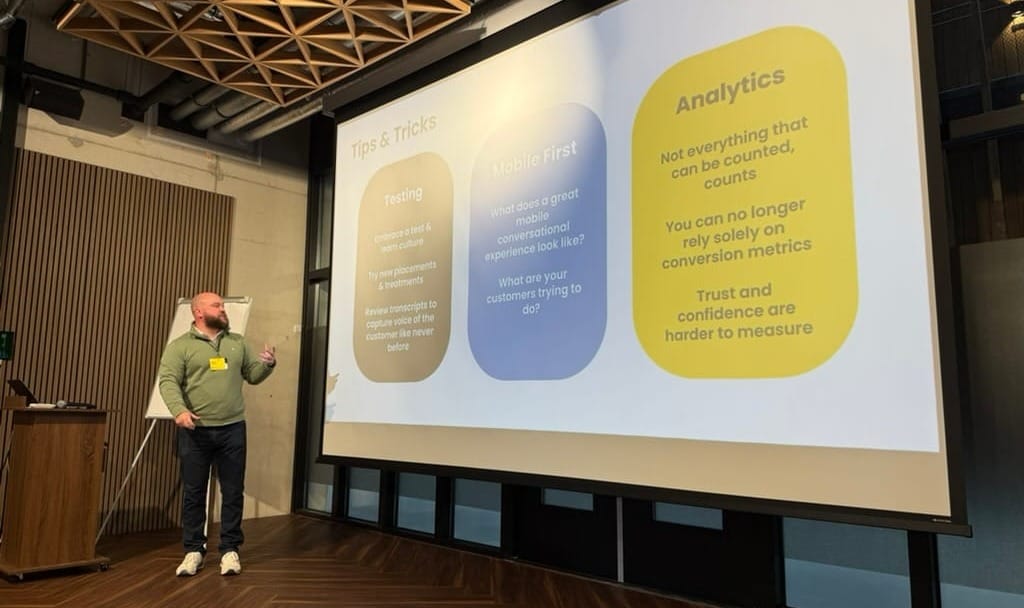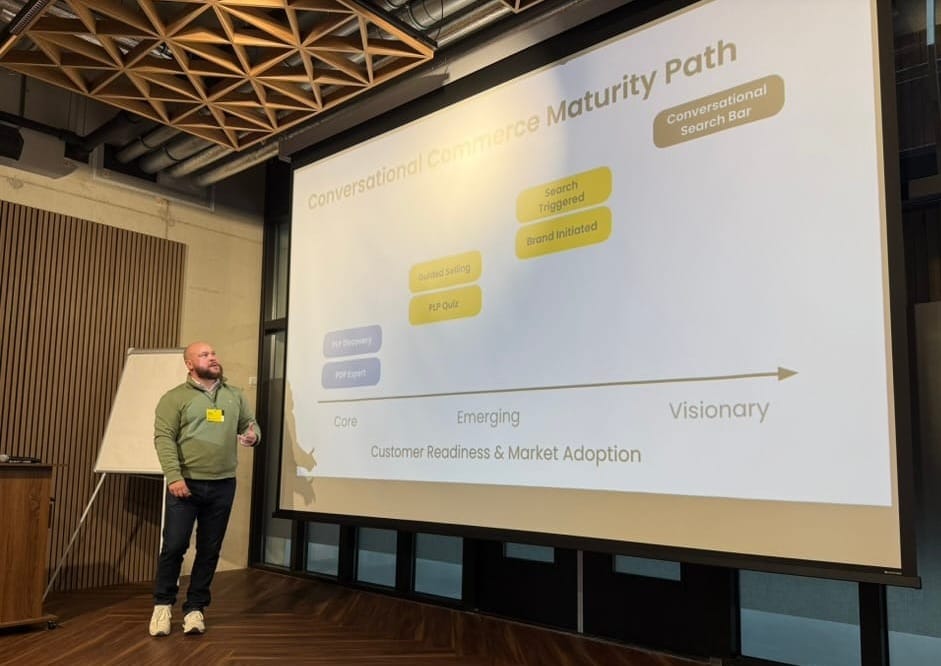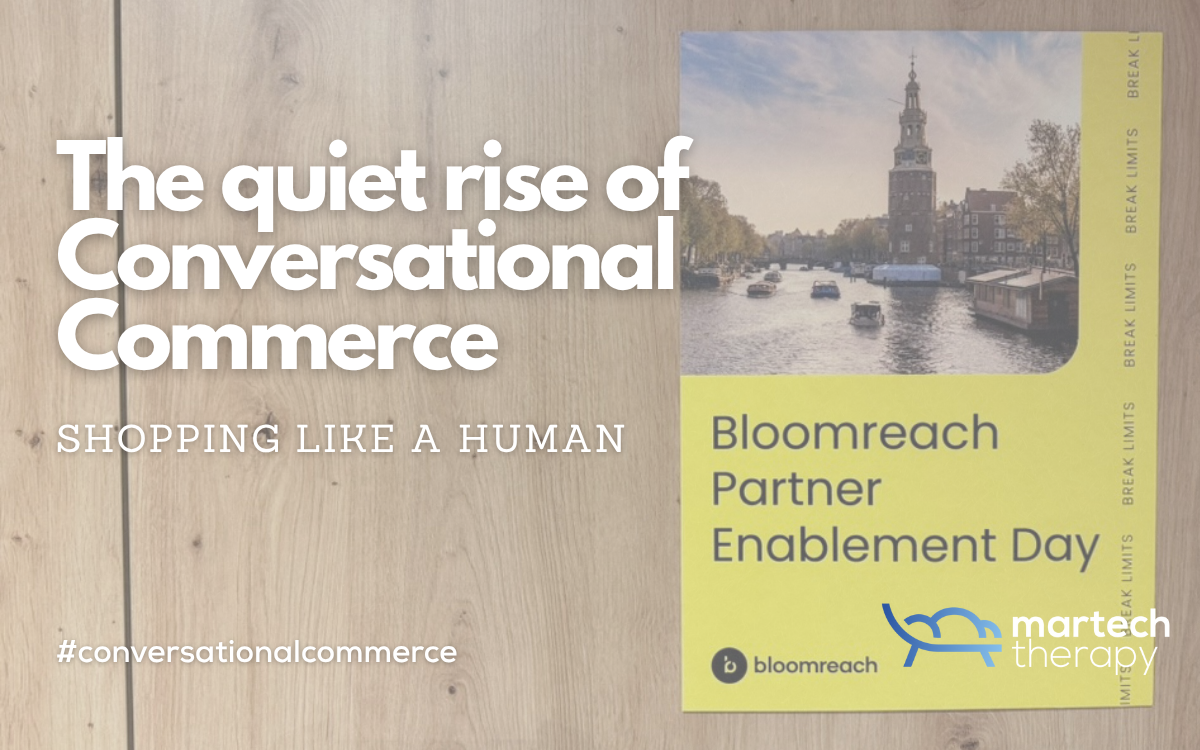I spent yesterday morning at the Bloomreach Partner Enablement Day event in Amsterdam, where Adam Hackett spoke about conversational commerce and the company’s new Clarity module. It wasn’t a pitch, more a quiet look at how online shopping is beginning to resemble an actual exchange, less filtering, more asking. The kind of conversation that once happened with a store assistant, now expressed through an interface.

Bloomreach’s framing felt grounded, it really did. They’re not trying to turn shopping into a chatbot novelty, we are no longer the naive consumers we were 10-20 years ago. They’re aiming to make it feel more natural, more human. Clarity sits at the engagement layer, helping marketers use what they already know about customers, without adding another system to maintain.
From funnels to fragments
For years, e-commerce design has followed a tidy mental model, the funnel. Discovery, consideration, purchase, retention, straight lines and clean metrics. But that’s not how people shop. We wander, compare, hesitate, and ask questions that no filter can anticipate. Then we, or I should say "I", search for that "ask your partner for permission to buy this" button. I know I am not alone in this.
“Shopping like a human” is a phrase that catches this reality. It accepts that intent is messy. Conversations meander. Decisions build slowly through questions, not just clicks.
The challenge for digital teams is that this messiness generates data that doesn’t fit into dashboards. Conversational systems change that dynamic. They collect a different kind of information, contextual, emotional, and situational. Instead of guessing what someone might want, the system can simply ask and adapt.
A quieter evolution
In my earlier writing about Contextual CDPs, I described how marketing technology is gradually moving from managing audiences to interpreting context. Conversational commerce is a visible sign of that same movement.
When someone asks a product question, they’re revealing more than preference. They’re exposing uncertainty, curiosity, and intent. That’s the kind of data traditional personalization engines often miss. And once captured, it can inform far more than the single interaction in front of it.
This is where Bloomreach’s approach feels pragmatic. The company isn’t promising fully autonomous sales agents. It’s giving marketers a way to listen, safely. The emphasis on brand protection, factual grounding, and tone control shows that we’ve learned from the first wave of generative AI enthusiasm. Accuracy matters more than novelty.
Real-time, or nothing
Still, conversational experiences live or die on responsiveness.
- A one-second delay in a search result is acceptable.
- A two-second pause in a conversation feels broken.
Latency is part of the emotional texture of the experience.
If conversational commerce scales, infrastructure readiness will suddenly matter in ways marketing teams aren’t used to measuring. Every hesitation, every missed beat, becomes a design flaw. It’s an entirely new layer of performance pressure, not because users demand speed, but because conversation demands rhythm.
Beyond the chatbot cliché
Adam shared a few examples of Clarity in action with contextual chat widgets that adapt to the product page, guided selling flows that mirror an in-store exchange, and conversational discovery replacing static filters.

The intent isn’t to automate salesmanship but to recreate something human, that moment when a good store assistant notices hesitation and asks if you’d like help. Digitally, that becomes a nudge similar to “You’ve looked at three jackets in similar colors, do you want to compare materials?”
When done well, this kind of interaction lowers friction without feeling invasive. It also reframes personalization. The system is responding to your intent in real time.
What happens next?
The natural question is how far these interfaces will spread. Will conversational discovery stay inside brand sites, or expand into broader chat ecosystems?
OpenAI’s Apps in ChatGPT now lets companies like Shopify and Booking.com make their products discoverable, and even purchasable, directly inside ChatGPT conversations. That means your next brand touchpoint might not be your website at all, but a chat window that already understands your inventory, pricing, and context.
Imagine asking, “Find me a jacket under €200 that’s breathable and suits Nordic weather,” and ChatGPT surfaces your product with an “add to cart” button right there. The line between webshop and assistant dissolves.
At that point, sites become reference destinations. The primary sales interface might live elsewhere, inside whatever assistant the customer already trusts. It won’t happen overnight, but it changes how we think about attribution, ownership, and what it even means to “visit” a store.
The invisible metrics
Near the end of his talk, Adam quoted the line often linked to Einstein: “Not everything that can be counted, counts.”. It landed well because conversational systems sit right at that tension. They generate enormous amounts of measurable data, yet the most valuable outcomes, trust, confidence, satisfaction, refuse to be quantified.

Maybe that’s healthy. We’ve spent years optimising for what’s easy to measure. Now, the next wave of Martech might re-introduce things that are valuable precisely because they can’t be captured in a dashboard.
A good conversation doesn’t always convert, but it does build comfort. And comfort, over time, is what drives repeat business, not just retargeting pixels.
Where this leaves us
I left the event thinking less about Bloomreach’s product and more about what it represents for the industry as a whole, a quiet return to dialogue.
Martech has spent a decade trying to predict people. Conversational commerce suggests we might get better at simply talking to them instead. It humanizes it.

Whether this approach becomes standard or stays niche will depend on how fast organisations can adapt their data, infrastructure, and patience. Real conversations can’t be rushed, even the digital kind.
But if Clarity and systems like it continue to evolve, they could remind us that every click, query, and question in marketing still begins with the same impulse: someone trying to be understood.
And maybe, after years of optimisation, that’s the kind of progress that matters most.



Discussion